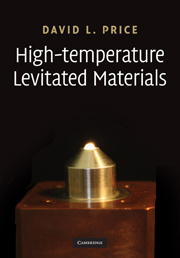9 - Conclusions and prospects
Published online by Cambridge University Press: 23 April 2010
Summary
It is hoped that the reader who has conscientiously struggled through the previous eight chapters has acquired a sense of the achievements and potential of investigating high-temperature materials with levitation techniques.
The acquisition of reliable thermophysical data on solids and liquids at high temperature must be considered among the major achievements, bearing in mind the difficulties that previous workers had in obtaining consistent and reliable data on contained samples at high temperature, especially those of a corrosive nature. One need only take the example of the density, an apparently humdrum quantity that is not only technologically important, for example in determining the ideal conditions for synthesis of crystalline silicon for the semiconductor industry, but also a vital parameter in materials research: a knowledge of the number density is needed to obtain useful real-space information from diffraction experiments, and furthermore it is the unique quantity that enters into a version of mode-coupling theory that has provided one of the most successful routes to understanding the dynamics of simple liquids, as well as an important parameter in ab initio numerical simulations.
A second achievement has been the ability to access metastable solid states. We have encountered several examples of new solid phases, especially glassy phases, that are not accessible with conventional techniques. Undoubtedly such phases will prove to have important technological applications in the optical and optoelectronic industries.
From the point of view of fundamental science, some striking accomplishments have resulted from the ability to access the deeply undercooled liquid state.
- Type
- Chapter
- Information
- High-Temperature Levitated Materials , pp. 204 - 205Publisher: Cambridge University PressPrint publication year: 2010

